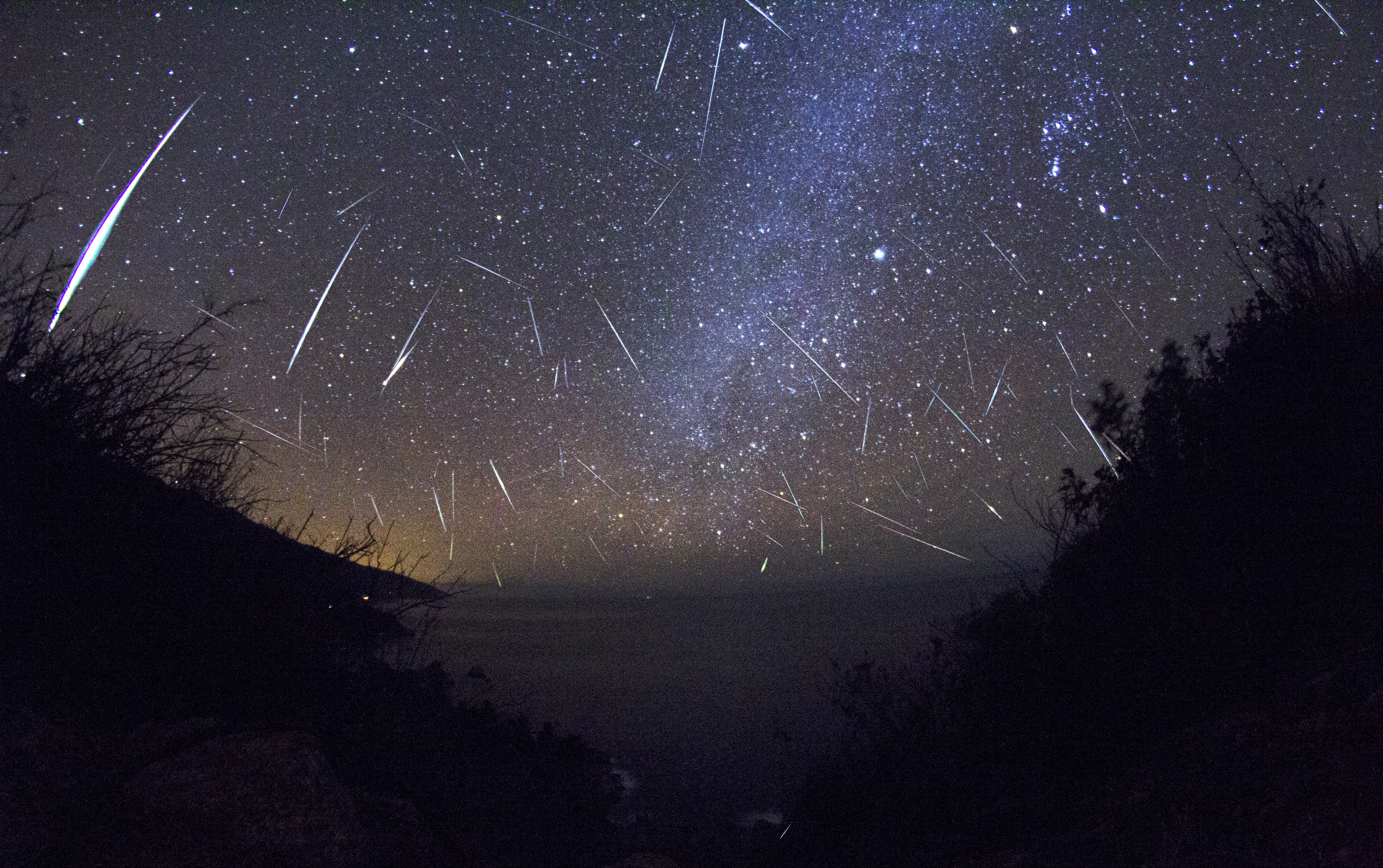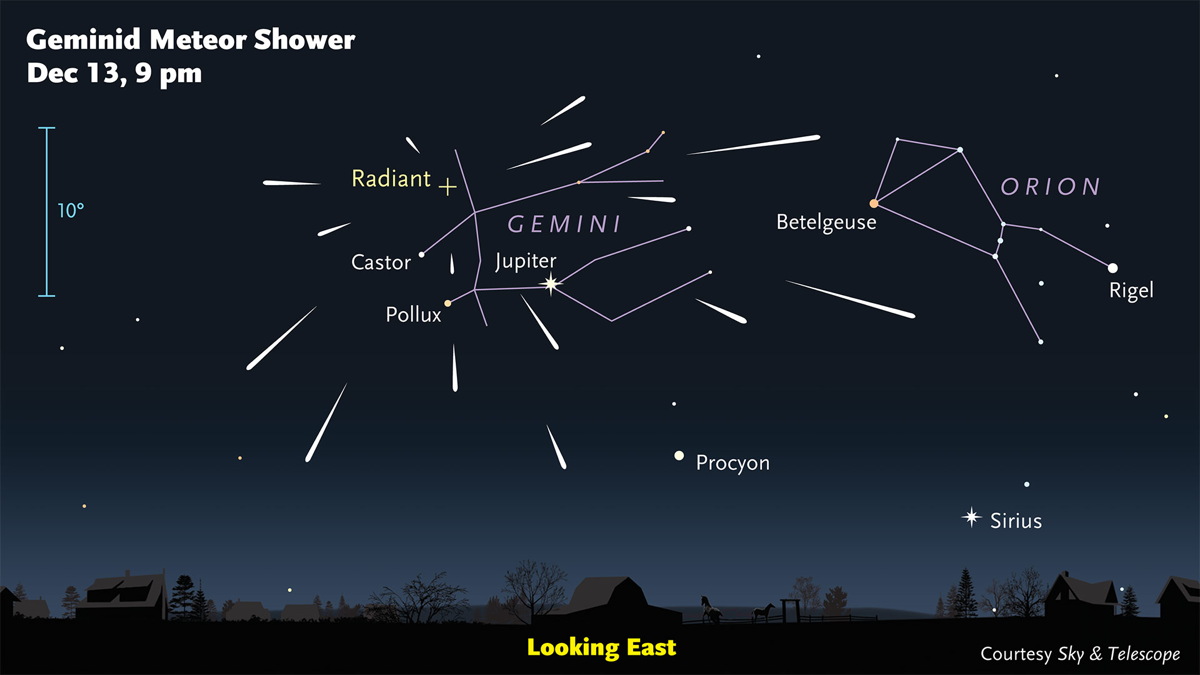Geminid Meteor Shower Peaks Tonight: How to Watch Live

One of the best meteor showers of the year is set to put on a performance tonight (Dec. 13), but if you can't catch the cosmic display in person, you can watch it live online.
The Geminid meteor shower — named for the constellation Gemini — is peaking late tonight into Saturday morning, potentially treating stargazers in light-free areas to about 90 to 120 meteors per hour. Observers can expect to get the best views of the shower, weather permitting, at around 4 a.m. local time in the wee hours of Saturday morning after the waxing moon sets, according to Bill Cooke, head of NASA's Meteoroid Environment Office.
"This year, there will be a magic hour starting at about 4 a.m. up until dawn that there will be no moon and you'll be able to see the Geminids in their full glory," Cooke told reporters on Dec. 11. Space fans everywhere can catch the meteor show live online through two webcasts from the online Slooh Space Camera and NASA. You can watch both NASA and Slooh's live webcasts on SPACE.com. [See Photos of the 2012 Geminid Meteor Shower]
NASA is hosting a web chat about the meteor shower beginning at 11 p.m. EST (0400 Dec. 14 GMT). Cooke and two of his team members — Danielle Moser and Rhiannon Blaauw — will answer questions from the public about the Geminids during the "up all night" webcast. The chat is expected to run until 3 a.m. EST (0800 GMT) and can be seen here: http://www.nasa.gov/connect/chat/geminids_2013a.html#.Uqr4FIZQGSo
Slooh will provide a free live feed of the Geminids from an observatory on the Canary Islands starting at 5:30 p.m. EST (2230 GMT) and running into the night, ending at 1 a.m. EST (0600 GMT). You can watch the webcast directly at www.slooh.com or by using the space camera's iPad app.

Geminid meteors appear to radiate from the constellation Gemini and have a reputation for being bright and slow. The shower can also produce brilliant fireballs that streak through the sky.
"The best thing to do to observe meteors is to lie flat on your back and look straight up," Cooke said. "You don't want to look at Gemini, you just want to look straight up and take in as much of the sky as possible because meteors can appear anywhere in the sky and the more sky you see, the better you chance of seeing a meteor."
Get the Space.com Newsletter
Breaking space news, the latest updates on rocket launches, skywatching events and more!
Meteor showers are created when Earth passes through streams of debris left behind by asteroids or comets. Pieces of space rock and dust are in space are called meteoroids and they become meteors when they burn up in the atmosphere. Meteorites are pieces of meteors that make it to Earth's surface.

"Those rates have increased over the almost two centuries since then by up to over 120 an hour," Cooke said. "This is because Jupiter's gravity is tugging that string of debris that comprises the Geminids closer to Earth as time goes along. Geminid rates over the next decade or century could exceed over 200 per hour."
Editor's note: If you have an amazing night sky photo of the Geminids or any other view you'd like to share for a possible story or image gallery, please contact managing editor Tariq Malik at spacephotos@space.com.
Follow Miriam Kramer @mirikramer and Google+. Follow us @Spacedotcom, Facebook and Google+. Original article on SPACE.com.
Join our Space Forums to keep talking space on the latest missions, night sky and more! And if you have a news tip, correction or comment, let us know at: community@space.com.

Miriam Kramer joined Space.com as a Staff Writer in December 2012. Since then, she has floated in weightlessness on a zero-gravity flight, felt the pull of 4-Gs in a trainer aircraft and watched rockets soar into space from Florida and Virginia. She also served as Space.com's lead space entertainment reporter, and enjoys all aspects of space news, astronomy and commercial spaceflight. Miriam has also presented space stories during live interviews with Fox News and other TV and radio outlets. She originally hails from Knoxville, Tennessee where she and her family would take trips to dark spots on the outskirts of town to watch meteor showers every year. She loves to travel and one day hopes to see the northern lights in person. Miriam is currently a space reporter with Axios, writing the Axios Space newsletter. You can follow Miriam on Twitter.









